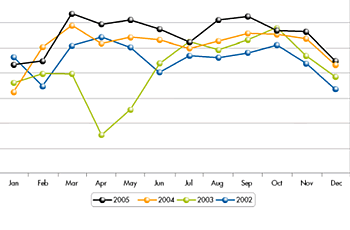ASIA PACIFIC. The Asia Pacific travel industry put the shocks of the previous two years firmly behind it in 2005, with record numbers of travel bookings, according to figures released by Singapore-based travel facilitator Abacus International.
In 2005, there were more than 54.3 million bookings on the Abacus system, an increase of +6% on 2004 and 36% on 2003. Total bookings showed healthy year-on-year upswings for all months except February, which typically records a slowdown in traffic following the Chinese New Year festive season travel surge around the region.
Monthly FIT bookings 2002, 2003, 2004, 2005 |
 |
Total bookings showed healthy year-on-year upswings for all months except February, which typically records a slowdown in traffic following the Chinese New Year festive season travel surge around the region ©Abacus |
“2005 was a robust year of growth for the entire Asia Pacific travel industry,” said Don Birch, President and CEO of Abacus International. “Although some regions saw tourism numbers dropping in the aftermath of the Tsunami, most travellers opted to visit a different area of Asia Pacific in the meantime while the clean-up and rebuilding were occurring.
“Attractive promotions by airlines and hotels following the Tsunami also helped fuel the recovery. While these offers were taken up very quickly, travellers continued to return, even after the promotions had finished,” said Birch.
Intra-Asia travel accounted for over 81.6% of bookings on the Abacus system during the year, outstripping all long-haul routes.
The total number of free and independent traveller (FIT) bookings during 2005 climbed +8% over 2004, +33% over 2003 and +22% over 2002. Events such as the invasion of Iraq and SARS coinciding in March 2003 had a ripple effect on the travel industry in the region, Abacus said.
The best performing months were March with more than 3.17 million FIT bookings and September closely followed with more than 3.12 million FIT bookings.
E-ticketing
Electronic ticketing (e-tickets) continued to gain in popularity throughout Asia Pacific in 2005, with more than one in every four tickets issued on the Abacus system being an electronic ticket. Some 4.8 million e-tickets were issued from January to December, a jump of around +70% from 2004 figures.
“Abacus is seeing a trend towards paper-free travel in Asia with more technology-savvy travellers opting for e-tickets. Paper tickets really are becoming a thing of the past, with travellers opting for the hassle-free ease and security of electronic tickets,” said Patrick Lai, Vice-President, Air Content Associates and North Asia at Abacus International.
“E-ticketing continues to be a very efficient and cost-effective travel option for not only the travellers, but also the travel agents and the airlines due to their booking flexibility and increased security,” said Lai.
While Abacus is technically enabled for electronic ticketing of nearly 60 per cent of all its tickets, the slow adoption rate of only a quarter of the tickets is an indication that more work may be required in this arena. While North and Southeast Asian markets have been on e-ticketing for a while, some South Asian and Indochina markets require more concerted efforts to move in line.
“With 29 airlines enabled for e-ticketing on the Abacus system, available to agents in 11 of its 24 markets, we need to work together as an industry to meet IATA’s stated objective of making air travel paperless by 2007,” Abacus said.
Taiwan led e-ticket adoption with over 1.35 million e-tickets sold in 2005, ahead of Hong Kong (1.23 million) and Singapore (1.07 million).
Asia Pacific travel growth
According to the latest IATA statistics – in passenger traffic measured in terms of revenue passenger kilometres (RPKs) – total Asia Pacific travel grew at +6.3% in 2005. The Association of Asia Pacific Airlines (AAPA) reported a +5.1% increase in 2005. Abacus recorded a +6% growth in total bookings in 2005 compared to the previous year.
E-tickets issued on Abacus System |
 |
Taiwan led e-ticket adoption with over 1.35 million e-tickets sold in 2005, ahead of Hong Kong (1.23 million) and Singapore (1.07 million) ©Abacus |
Influencing factors in this growth included the increases in business relationships between Asia and the Middle East, inter-regional trade with China, along with contributing factors in the aviation industry such as low-cost carriers stimulating overall demand for travel and robust investment in the hotel sector, especially by international chains.
“The economy in Asia Pacific is predicted to sustain robust growth; as travel growth is related to that, we are anticipating travel growth across the region in excess of +4-6%,” said Birch.
“As a result, we can expect to see the major airlines in the region and beyond adding sufficient capacity to meet this growth,” he added.
Abacus travel predictions for 2006
Birch’s key predictions for Asia Pacific travel in the year ahead are:
Asia Pacific consumer habits are rapidly changing
“The growing number of travellers is fast changing the travel landscape in Asia. Their needs are becoming more complex and demanding. For example, mass travellers prefer the traditional travel agent service, competitive pricing and travel more often; while on the other end, the elite travellers seek authentic experiences and customised itineraries,” Birch predicted.
“Travel is no longer a luxury for most people throughout Asia, it is a necessity. This demand for travel is from both business and leisure travellers, and although airlines continue to be affected by higher fuel prices, the increase in ticket prices and added fuel surcharges have yet to deter the Asia Pacific traveller,” he said.
Not only are habits changing, but according to a recent MasterCard survey, Asia’s ageing population is also producing a new group of wealthy frequent flyers with more leisure time. Household incomes are rising with the number above US$100,000 per annum set to increase by +13% to 17 million by 2014. Similarly, their travel spend is predicted to double in ten years, reaching US$17.6 billion.
Female travellers are becoming the fastest-growing sector in Asia Pacific. The survey claims that by 2010, an estimated US$13.4 billion will be spent by women in four leading Asia Pacific destinations – Seoul, Hong Kong, Singapore and Bangkok.
Moreover, women are not only shaping travel demand patterns by travelling independently, they are also the travel organisers and decision makers for the entire family, making around 70% of all travel decisions, according to the Pacific Asia Travel Association (PATA).
Airlines will look for new ways to incentivise travel
Birch predicted that although 2005 was a golden year for low-cost carriers (LCCs) in Asia, 2006 will see new LCC players as well as further consolidation of LCCs in other markets.
“The low-cost carrier in Asia has begun to mature and expand. This expansion is good for the entire travel industry, stimulating demand for travel across the board, driving the development of tourism infrastructure, creating jobs and delivering choice and convenience for travellers. Airports such as the new Budget Terminal at Changi Airport in Singapore opening in March this year will attract more visitors and expand the market for both LCCs and network carriers,” he said.
“With the need to operate under tighter costs and offering increased discount fares, LCCs will increasingly see the benefits of working with travel agents and GDS’s. As LCCs find their place in Asia, more will adopt GDS distribution, particularly in markets where the effectiveness of direct distribution is limited by the availability of the Internet.
“Full-service airlines will look at new ways to incentivise travel and provide good deals for their customers on both their long-haul and short-haul routes. It is anticipated that the business traveller will remain one of the key customers of full service traveller, retaining loyalty for their reliability in service, flight times and added membership and alliance benefits,” Birch predicted.
Technology will shape the way the travel industry does business
Abacus believes the Internet will perhaps be the single most important factor in the future and growth of the travel agent industry.
While travel and tourism is the second largest industry in the world after agriculture, it has yet to fully tap the potential of this new technology. Many travel service providers either do not use Internet Protocol (IP) standards or do not take full advantage of the greater speed, functionality and connectivity IP offers.
Birch predicted that while online travel in Asia continues to rise, so does the complexity in travel solutions and the abundance of information. “This is why the need to adopt IP is acute for airlines, but even more so for travel agents,” he explained. “Travellers overwhelmed by the choice, or those with multi-segment travel plans, will begin to rely more heavily on travel agents to provide solutions to their complex travel itineraries and to seamlessly manage their composite door-to-door itineraries.”
IP technology will make it easier for travel agents to automate systems, such as ticket refunds, and provide access to online services such as e-mail. In the longer term, travel agents that understand what IP technology can do for them will seize a competitive advantage and pave the way for their future expansion and growth.
“To best support travel agents to retain loyal customers and increase their revenue opportunities, GDSs will need to focus on continually evolving and developing their IP solutions bringing with it better service and convenience to the traveller,” said Birch.
Birch further predicted that as technology in air travel becomes more widely accepted in Asia Pacific, value-added services such as electronic ticketing will begin to see the phasing out of paper tickets this year. “Once adopted, savings can be as high as S$25 per ticket for airlines, providing ease of convenience for travellers and airport ground handling staff and the ability for travel agents to more effective management their customers’ itinerary.”
“I predict that as fuel prices increase and low-cost carriers continue to shape travel in Asia, airlines will continue to look for ways to reduce their overheads and maintain positive profit margins. Service providers such as GDSs will come under the microscope, with systems such as the ticketing and pricing systems being squeezed to provide more functions and functionality for the same cost. Tailored solutions and pricing systems will become a necessity, with the relations between GDSs and the airlines playing an increasingly important role in ensuring the right balance is met,” predicted Birch.
“Airlines will need to work closely with GDSs to discover smarter ways for technology to provide efficiencies and help reduce operating costs,” he added.
Evolution is the key
Birch predicted that with the changes facing the travel industry in the short- and long-term future, the travel agent’s role is expanding and becoming more important now than ever.
“The challenge for the travel agent is to create sustainable value for the traveller in this new travel environment. Increasingly, travellers are turning to multiple channels to look for the best travel deals, with the Internet one of the most popular channels. As a result, airlines are now going direct to the traveller and impacting the traditional role of the travel agents in the matured economies,” said Birch.
With increasing pressure on costs and rising operational costs, the old way of doing business is no longer sustainable and travel agents must change, just as some of the major airlines have done.
“Ultimately, agencies are faced with two choices. One option is to move towards agency consolidation. This is already happening as the traditional ‘mom and pop’ shops are not big enough to invest in the technology to survive. By becoming big, they will be able to adopt various channels to engage their customers on all fronts. The second option is to carve out a niche that allows them to use their competitive advantage of being small to provide specialised and personalised service in niche markets.
“As part of this change, the GDS model will also have to expand its travel offerings in its sphere as the single point of sale for travel. In addition to its air content, the non-air content and travel information must be rich, easy to book and drive travel agent usage.
“The key to success for the entire travel industry will be built upon understanding the individual customer and delivering genuine value,” he said.
Markets influencing travel in 2006
“Regional travel will continue to be driven by the growing economies and populations throughout the Asia Pacific region. We are expecting that most markets across the region will achieve a modest travel growth rate in excess of +4-6%, with star markets such as India and China set to reach +9% and +12% travel growth respectively,” revealed Birch.
Growth from the Middle East will play a large part in shaping travel in Asia this year, with the anticipated expansion of its airports and home-based carriers – Emirates, Etihad Airways, Gulf Air and Qatar Airways. Airports where these airlines are operating from are spending nearly US$19 billion to modernise and expand (source: Orient Aviation, February 2006). With new cities, routes and services being added almost weekly by one of the airlines, new stopovers and varied destinations are quickly becoming a priority. And Asia is perfectly positioned for the stopover between continents between the Middle East and Australia, the US or even Europe.
Intra-Asia travel on the Abacus system is set to continue to outstrip all long-haul routes in 2006. Business relationships between Asia and the Middle East will carry on being forged, inter-regional trade with China will be high on the priority list for many businesses and governments, and the aviation industry will continue to contribute to the increase in bookings.
“However, to support this growth, some of the markets around the region are lacking in adequate aviation and technology infrastructure,” said Birch. “Hence, as an industry leader in the region, it will be up to us to assist in helping markets work around these issues while providing airlines and travel agents with the best tools possible to facilitate seamless travel.”
Other challenges around the region that may impact the travel growth include the possibility of an escalation in the situation with avian bird flu, geopolitical uncertainties such as civil unrest, the ongoing threat of terrorism, lack of liberalisation of the aviation industry and internal market politics slowing the privatisation and development of infrastructure.
“My strongest prediction is that amid all the possibilities and what-might’s of the year, travel outlook will remain fairly robust throughout, and the industry will continue to work together to keep the customers happy, the region safe and the tourism dollar coming in,” said Birch.
About Abacus International
Singapore-based Abacus International is the Asia Pacific’s leading travel facilitator with more than 11,000 travel agency locations in 24 markets. Abacus provides travel information and reservations tailored to the Asia Pacific region.
Abacus International is owned by Sabre and a consortium of Asia’s leading airlines, including All Nippon Airways, Cathay Pacific, China Airlines, EVA Airways, Garuda Indonesia, Dragonair, Philippine Airlines, Malaysia Airlines, Royal Brunei Airlines, SilkAir and Singapore Airlines. Sabre is the US-based leader in the electronic distribution of travel and travel-related services. Visit www.abacus.com.sg
MORE STORIES ON ABACUS INTERNATIONAL
Another record year for Asia travel says Abacus – 07/12/05
Asia Pacific travel growth remains strong says Abacus – 16/11/05
Asia travel bookings up +19% in August says Abacus – 06/10/05
















